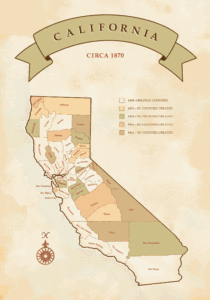When the State of California was created in 1850, it designated Sonoma County one of the original 27 California Counties, and the City of Sonoma was selected as the County Seat. Over time this changed and the County Seat moved to the biggest city in Sonoma County, the City of Santa Rosa.
This post will discuss some of the milestones which occurred in Sonoma County history. We’ll start with this table, which is a summary of the development of the Cities which make up Sonoma County.
The Cities of Sonoma County
[table id=1 /]
Another interesting note in Sonoma County’s history is it took sex seriously. Besides General Hooker’s house in the City of Sonoma (which is how the word “hooker” came to mean prostitute – during the Civil War, General Hooker let the Ladies camp near his Troops and over time they became known as Hooker’s Girls … and then Hookers) the county was home to many brothels and bordellos.
Before Wine, it was Women and Song
 While The “oldest profession” was outlawed in California in 1872, it persisted and was even tolerated to a certain degree in Sonoma County.
While The “oldest profession” was outlawed in California in 1872, it persisted and was even tolerated to a certain degree in Sonoma County.
According to the book “Hidden History”: “Guerneville had its ‘cribs,’ Petaluma had its ‘Green House’ and Santa Rosa had its ‘Tenderloin,… ”
During the 1890s, Santa Rosa’s red light district was located just south of Chinatown, near Santa Rosa Creek. It encompassed the area of First Street from Main (today’s Santa Rosa Avenue) to E Street, and D Street, between First and Second streets, according to the book.
Today, the Main Post Office in downtown Santa Rosa is located near the heart of the old red light district.
At the turn-of-the-century, there were five or more known brothels in close proximity, some owned by one of Santa Rosa’s largest property holders. However, the houses of ill repute offered more than just sexual favors.
One known as the “Chicken Coop,” had grooming services. And all brothels were allowed by the city to serve liquor after buying a license for $15 per month, even though the businesses operated neither as restaurants nor saloons.
Business was especially brisk when the horse races were running at the fairground. Men, awaiting their turn with the ladies of the night, would form lines along the fences opposite the bordellos.
Property values
Men would line up along the fence, across the street and the racket, the language and the smoking really offended the neighbor. In addition, the working women and patrons also could often be seen in the windows in various stages of undress.
The Santa Rosa City Council, in May 1907, passed a resolution specifically defining the boundary of the red light district. Among other things, it required establishments to be licensed, which also included each “guest” to be inspected by a doctor and subject to vacating the premises if a contagious disease was found.
End of an Era
Eventually the bordellos closed and during the 1920s the general area for that type of business moved south to neighborhoods of Santa Rosa Avenue.
What else is there to discover? Come on out for a visit and find some adventure yourself!
Visit Sonoma County!
To learn more about Sonoma County’s History consider a Tour with a Certified Tourism Ambassador!
